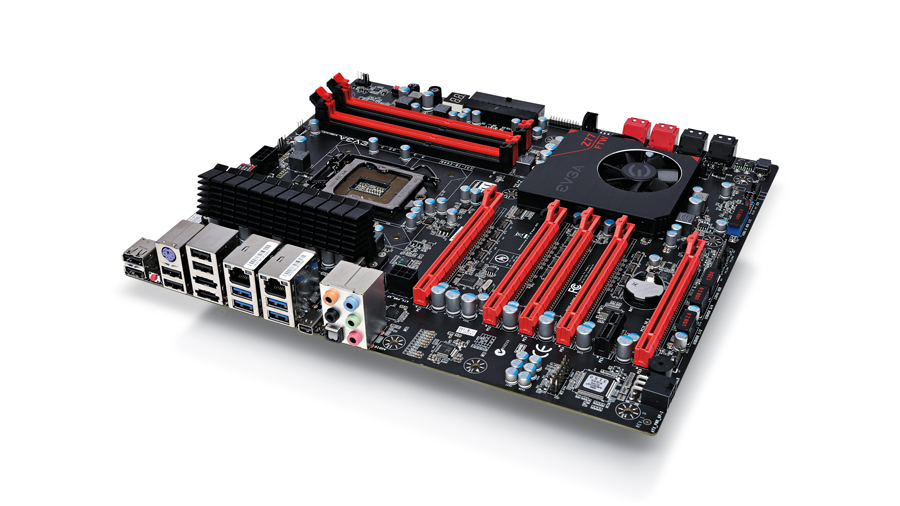TechRadar Verdict
Pros
- +
Huge amount of features
- +
PLX chip
- +
Five PCI-e 16x slots
- +
Twin ATX 12V power ports
Cons
- -
DisplayPort video out
- -
Not one for novice overclockers
Why you can trust TechRadar
Here at PCF we love the Z77 chipset, so expectations were high for this EVGA board. The Z77 is our weapon of choice for LGA1155 Intel CPUs - a chipset without compromise, giving you the full range of CPU features and overclocking options - such as they are with Intel's ever more locked down chips.
But it's pricey, the MSI Z77 FTW. It's impossible to justify compared to Z77 boards at less than half the price. So investing in this mobo is an emotional choice, not a rational option. And there's certainly plenty to pull at your consumerist, materialist heartstrings.
It's a really nicely presented board, finished in a lush looking matt grey coating. All the usual high-end accoutrements are immediately apparent, too. LED debug display? Check. Power and reset buttons? Yep. Clear CMOS switch on back panel? Affirmative. More USB 3.0 ports than you can shake a memory stick at? Uh huh. Three BIOSes with hardware selector switch? Oh yeah.
Serious tuning
Of course, in many ways, those are the superficial bits. It's the detailed configuration and component choices that will make the difference on what is a proper bit of overclocking hardware.
Doubling up on eight-pin ATX power supply ports is nice start, so rest assured, you're not going to have any problem keeping this board juiced. The BIOS looks kind of sexy in a monotone, steampunk sort of way.
This board has been made with pure power users in mind, so there are plenty of hardcore features, with little in the way of auto-overclocking tools.
The presence of a PLX chip and a metric ton of PCIE-16 slots also means the FTW is a good choice for serious multi-GPU gamers, adding some precious PCI Express lanes. EVGA has kept eight lanes separate, side-stepping any problems you might have with the PLX chip when overclocking with a single card.
There are a few oddities, though. The main ATX power rail is mounted at a right-angle to the norm, which could cause a problem depending on the layout of your case. The video-out port for integrated graphics is in DisplayPort format. EVGA has bundled a DP-to-HDMI adaptor, but it's still a little off-putting.
Benchmarks
CPU rendering performance
Cinebench R11.5: Index score: Higher is better
EVGA Z77 FTW: 7.49
MSI Z77 MPOWER: 7.59
Video encoding performance
X264: Frames per second: Higher is better
EVGA Z77 FTW: 41
MSI Z77 MPOWER: 43
CPU gaming performance
Shogun 2: Framer Per Second: Higher is better
EVGA Z77 FTW: 34
MSI Z77 MPOWER: 36
As for performance, at default settings the FTW is a bit of a dullard. You won't get very far just ragging it, especially if you just jump into the BIOS and ramp up the multiplier. That's mainly because the BIOS doesn't offer any easy routes to ideal CPU voltage settings. You can't just set the voltage to auto and expect the BIOS to cook up something suitable - you have to tune it by hand.
A quick bump to 1.35 volts and we hit 4.7GHz with a 3770K, which is a decent result by any metric. Spend a little more time fine-tuning and we reckon the FTW will be up there with the best.
What's it's not, however, is hugely user friendly. To get the most out of it, you'll really need to know your stuff. And that, as much as the price, is why this is a board for the keenest of enthusiasts only.
Technology and cars. Increasingly the twain shall meet. Which is handy, because Jeremy (Twitter) is addicted to both. Long-time tech journalist, former editor of iCar magazine and incumbent car guru for T3 magazine, Jeremy reckons in-car technology is about to go thermonuclear. No, not exploding cars. That would be silly. And dangerous. But rather an explosive period of unprecedented innovation. Enjoy the ride.
